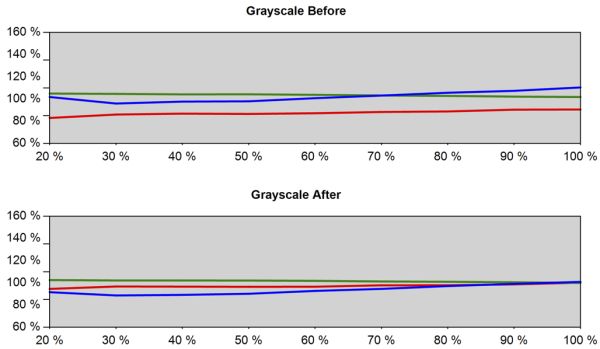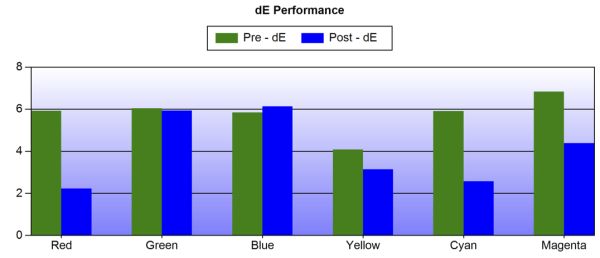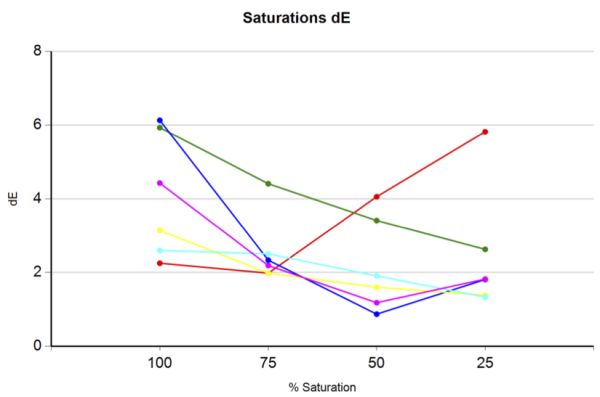BenQ EW2420 Monitor Review
by Chris Heinonen on October 13, 2011 12:00 AM ESTAV Use and Calibration
With its multiple HDMI inputs, speakers, and headphone jack, the EW2420 is specifically designed to be used not only as a computer display, but also for your video game system, Blu-ray player, or cable box. To test this, I went ahead and calibrated the HDMI1 input using an Oppo BDP-93 Blu-ray player as the source at 1080p resolution. The test pattern source was the AVS HD 709 disc that anyone can download from the AVS Forums website for free, and measurements were done using ChromaPure calibration software and an X-Rite i1DisplayPro which has custom offsets for different display types, including LED lit LCDs.
The first issue that came up was trying to set the brightness correctly using a PLUGE pattern. When I set the Oppo to output RGB Video Level content over HDMI, no matter how low I set the brightness, I couldn’t get video levels below 16 to stop flashing. Ideally, video level 16 should be barely visible when it flashes, and nothing below that should be there as 16 is the darkest level that should be encoded on consumer HD content. If I switched to YCbCr 4:2:2 or 4:4:4 video output, then no matter how high I turned the brightness, video levels below 18 wouldn’t flash. This left me with the choice of either severely washed out shadow detail with an RGB signal, or missing the very darkest shadow detail with YCbCr output. I chose YCbCr, as RGB looked far worse on material.
With the Contrast, there is a similar pattern on AVS where you attempt to set contrast high enough to hide all the flashing blocks above video level 235, which is peak white. Sometimes you might stop before then as it would be too bright, in which case you can use a 100% white pattern and set the light output to a level you want (such as 120 nits or 35 foot-Lamberts). With the BenQ, once the contrast got above 40, the white background and gray blocks started to take on a red tint, which often happens with a digital display if you set the contrast too high. I dialed the contrast back to before this happened, which still left a lot of blocks above 235 flashing, but I still had 190 nits of light output to work with. You could easily dial this back quite a bit and still have a good image for a dark room, but this would work well with plenty of lighting from a distance.
Despite the labels on the Gamma settings, I found that 2.2 was producing a gamma curve around 2.45 and 2.0 was producing just under my target of 2.2. Since 2.45 would be very dark, and we’re already losing some shadow detail due to the colorspace issue I talked about earlier, I chose the 2.0 value for the calibration. I tested all of the video modes on the BenQ for the grayscale and the Standard mode was the closest to 6500K in temperature at 100% white, so that is what I chose to use. As you can see from the Grayscale Before chart, it was lacking in red all across the spectrum.
The BenQ also only offers one set of RGB gain controls for the white balance. I chose to set the 100% white point with them, though I’m not sure that’s the correct choice. Values around 70% or 80% are more common with televisions, so I might choose that as my target white point calibration level, since it would potentially even out the curve both at the top and the bottom and possibly lead to a lower dE overall. Adjusting these controls is also going to affect your Gamma curve, so you need to go back and forth to make sure these are working together OK.
Beyond these controls, the only things I could set with the BenQ are a Color control (labeled as Saturation) and Tint (labeled as Hue). The saturations were actually quite accurate for a display and it only took one click up to 51 to get the levels correct. Hue was just one click high and setting that down to 49 led to a very nice measurement for Cyan (which is used to set Tint). One feature in ChromaPure that I like is the ability to measure different saturation levels for colors and not just the standard 100% values that you will see. It is pretty rare to see a 100% value in real world content, and having those intermediate saturations correct is very important. Here we can see that with the exception of red, all colors start out with lower dE levels and then rise up to their highest dE level at 100%. Given the relatively small number of adjustments that could be made to color, this was a very nice result in the end.
I quickly tested the video processing capabilities of the EW2420 as well. It won’t accept a 1080p24 signal, so you cannot output that from your Blu-ray player if that’s what you intend to do. It also failed deinterlacing for video (2:2) and film (3:2) content pretty miserably. Because of this, make sure to set your source content to 1080p and not 1080i for use with the display, as otherwise jaggies and other artifacts will be visible in the content. It did pass all chroma and luma detail at 4:2:2, 4:4:4, and RGB colorspaces correctly, so that was good. The fact that it skews the levels of content based on colorspace is a bit of an unattractive feature, however.
The best compromise for using the monitor in both a video display and PC setup would be to calibrate the monitor using a Blu-ray disc as I did, and then calibrate it on the PC, but not in DDC mode. Almost all of the necessary corrections could then be done in the video card LUTs without affecting your image that was calibrated correctly for video content. Since we were able to get almost 200 nits out of our calibrated settings as well, it should work fine in this setup as long as you do the video settings first for the best results.














47 Comments
View All Comments
cheinonen - Thursday, October 13, 2011 - link
The SA750 is on hand and up for review soon, though probably behind a couple of other panels that are already here, one of which is TN.JMS3072 - Thursday, October 13, 2011 - link
Can you speak to the volume of the headphone jack when using high-impedance (32Ω or greater) headphones?cheinonen - Thursday, October 13, 2011 - link
I can't right now but I can try to hook them up tomorrow and give it a quick listen. The headphones I have on hand are 32 ohm (Grado SR60) or AKG K701s that are a huge pain to drive, and I'm certain it won't be able to do a decent job on at all. I will try with the Grado's and see how it does, though. I focused more on the speakers than on the headphone output.cheinonen - Friday, October 14, 2011 - link
I got a chance to hook up my Grado SR60s to the BenQ, playing back a Blu-ray over HDMI. Even with the volume cranked all the way up it really wasn't that loud, much quieter than I would expect. If I had headphones that were hard to drive, I certainly wouldn't count on it putting out a decent volume level.ncomben - Thursday, October 13, 2011 - link
What is it with all these 16:9 monitors - can we have at least have reviews of proper monitors for PC users who do more than just watch films or play console games?I believe the panel makers are doing the public a great injustice in the name of reducing costs and standardising across markets. I can almost understand reviewing below 24" at 16:9 since the headline resolution sounds better than a 16:10 screen much better but at 24", come on...
I'm a developer and, I would argue that the 22" 1680x1050 monitors I am currently using are vastly superior to use than the newer tiny 22" 1920x1080 screens that my company buy for new developers.
I use a 16x10 24" at home for gaming, development, films &, browsing and it's perfect.
We recently got a 27" in the office to try out... it's going back because nobody could read the fonts!
Then again, perhaps it's just me?
cactusdog - Thursday, October 13, 2011 - link
That makes no sense....."I'm a developer and, I would argue that the 22" 1680x1050 monitors I am currently using are vastly superior to use than the newer tiny 22" 1920x1080 screens that my company buy for new developers."
Absolutely no sense when you have less verticle resolution. I'm getting a bit sick of hearing this debate 16:10 vs 16:9, Sure, some people will prefer the extra verticle resolution of 1920x1200 vs 1920x1080 but the ratio argument fails if you prefer a 1680x1050 over a 1920x1080.
Resolution matters, ratio does not. It makes no sense to prefer a smaller res just to get 16:10.
And I agree about testing the SA750/SA950. They are very nice monitors and have better colour reproduction than mainstream IPS monitors.
Rick83 - Thursday, October 13, 2011 - link
The real problem isn't 16:10 or 16:9.the real problem is, that 4:3 and 5:4 are dead, especially in larger than 19 inch screens.
I'm looking for an excellent 1600x1200 screen to get three of, and use them in portrait mode, but it's almost impossible, because the Eizo s2100k is apparently the only high quality display that's not costing an arm and two legs, while still offering reasonably thin bezels and usb-auto-calibration. Sadly, that screen hasn't seen a refresh for more than 6 years, and only old stock is being sold.
At that size and resolution it's also unpractical to go for single displays, and even a good 30 incher is already more expensive - and also going the way of the dodo.
Seems like screen real estate isn't that sought after anymore :(
bobbozzo - Thursday, October 13, 2011 - link
Dell is still selling their 20" model 2007 LCD which is 1600x1200, but it's $399, i.e. the same price as a Dell 1920x1200 24" IPS monitor.imaheadcase - Thursday, October 13, 2011 - link
It does make sense in a personal experience aspect. Once you use a 24inch 1920x1200 using a x1080 just "feels" wrong. You fill ripped off. Games especially. It just feels the screen is tearing.kmmatney - Thursday, October 13, 2011 - link
" I'm getting a bit sick of hearing this debate 16:10 vs 16:9, Sure, some people will prefer the extra verticle resolution of 1920x1200 vs 1920x1080 but the ratio argument fails if you prefer a 1680x1050 over a 1920x1080."Well, you going to keep hearing it - 16:9 sucks. I work in 1920 x 1200, but if I had a choice, I'd pick a 22" 1680 x 1050 screen over 1080p (for work). It makes sense if you spend all day trying to work with the 2 resolutions.